How to Optimize Speed for Better SEO – Our Actions and Results for Flowmatters.com
To ensure your website’s success and keep your customers happy, you should know how to take action for website performance optimization correctly. Web performance issues and a low site speed affect search engine rankings and user experience (UX). Taking the rights steps into eliminating your website’s speed issues, improving the server response time, and having a mobile-first indexing mindset will boost your website’s overall performance and increase your search position in the organic results.
Since we started the Flowmatters blog, we wrote and published numerous blog articles about the topic of website performance optimization, where we dive deep into the importance and the need for a faster page speed and an excellent website for both desktop and mobile.
Now it is time to show you precisely what we did for our website and what we managed to achieve. Follow along to uncover more details.
What Is SEO?
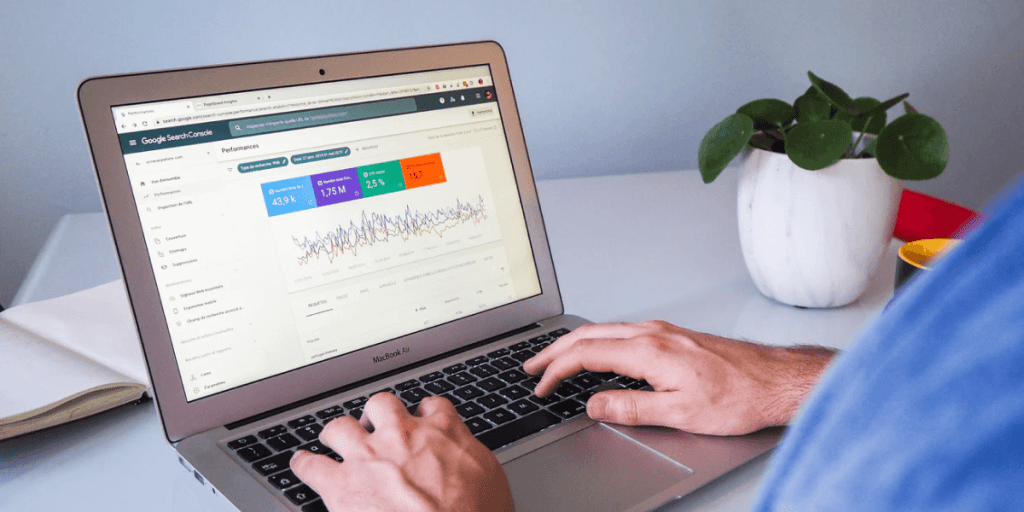
Search engine optimization or SEO is the process of optimizing your website to improve the quality and increase the website traffic to your website or a web page through the search engine results page (SERP). This is called organic traffic (unpaid traffic). This type of traffic can come from different types of searches such as image search, exact-match keywords, video search, industry-specific search terms, etc.
A solid SEO strategy will help your target audience find you easier and faster when they type a search query related to your company, products or services. Your online visibility increases and they will get a better chance of finding your website and convert to customers. For example, a blog is a major factor in boosting your search rankings and plays a critical role in making your website more visible. It helps to bring organic search traffic to your site. By implementing a good SEO practice, a user searching a keyword related to your products or services might have a better chance of finding your blog post, therefore, find your business.
Why Do We Optimize Our Websites for SEO?
There are multiple reasons why we recommend speed optimization and SEO actions to be made at the same time. They work better when implemented together. We offer both digital marketing and website performance optimization services. Therefore, we must lead by example, show our partners that we are a team of skilful experts, and they can count on us for helping them achieve better results.
Indeed, each business and niche has specific needs and different objectives, but in the end, we all want the same results:
- Reaching our target audience and buyer personas.
- Increasing our search engine ranking and bringing qualified traffic to our website.
- Keeping our visitors engaged.
- Having a fast performing website.
- Converting users into customers.
Reaching your target audience and buyer personas
To achieve these results is not an easy job, but with the right team on your side, you can avoid a poor user experience by improving SEO rankings and website loading speed.
The search engine giant Google is the largest and most used search engine. Website owners should first understand its purpose before making any changes to their websites. Google is focusing on:
- Deliver the most relevant content for the audience based on user intent.
- Offer a fantastic user experience.
- Prioritize quality content that brings significant value to users’ search queries.
We emphasised Google’s purpose because it is the same as ours. The difference is that we approach it differently. As the largest search engine analyzes millions of websites each day, we create user behaviour reports.
Google uses more than 200 ranking signals when deciding which piece of content should be featured on the first page of the search engine results.
When you focus on on-page SEO, we advise you to use a primary keyword and two-three secondary keywords related to search intent. Your content should be focused on what people will love to read and provide meta information (meta title and meta description) to help Google understand what your content is about.
When you focus on conversions, you should guide your website visitors toward a specific goal: subscribing to your email list, buying your products, downloading an ebook, etc. In this case, just like Google, you give your audience exactly what they are looking for.
Here is how we do it:
- We check Google Search Console, a free online tool provided by Google to identify keyword ideas, keyword phrases, long-tail keywords based on search terms in our industry and keyword rankings.
- We compile a list of keywords of interest for our target audience.
- Based on the findings, we optimize our website pages content to increase the quality of our general content.
- We review our description metadata and keyword metadata and align them to the page’s updated content.
- We constantly monitor the performance of our content optimization and target keywords using Google Analytics and Google Search Console.
Increasing our search engine rankings and bringing qualified traffic to our website
Usually, the average business spends 1% of its total revenue on advertising. It might not seem much, but it adds up. If your business makes 1 million dollars per year, you might spend 10 thousand dollars on advertising. Attracting organic traffic through SEO is free. The conversion rate difference between relevant searches that land on your website via organic search and those who come through paid ads is significant. Organic search converts almost 15%, while paid search converts less than 2%.
We strongly recommend investing time in growing your organic traffic, even if it takes longer to show results. Have patience because the results will last longer. When Google notices that your content is of interest and keeps your visitors engaged, it will rank you higher in the SERP. Besides that, increased conversions will become normality and not a struggle.
Here is how we do it:
- We invest a lot of time into our blog.
- We write about development, marketing, and web design.
- Each blog category links to the related services and solutions.
- We use internal linking and outbound links.
- We link to trustworthy sources to sustain the facts listed in our articles.
- We use title tags to help Google better understand the content of our pages.
- We are consistent in our content marketing efforts by posting a new article once a week.
- We support SEO traffic with Google ads.
- We have a fully updated Google My Business profile.
- We are patient. It takes from three to six months to see results.
- We adapt our content strategy based on the results.
Keeping our visitors engaged
After users access your website, you want to keep them there, create a positive experience, and encourage them to convert and return. Analyze how users navigate your website, how much time they spend on your site, what pages are of interest, do they scroll down the page, click on your CTAs (call to actions), etc.
The most important is to encourage your visitors to follow you on social media, sign up for email lists, read your blog post, visit your product or services pages, etc. Besides the existing traffic, keeping visitors engaged helps conversion rate because organic traffic does convert. It is essential to know your audience and present your products and services to them in an attractive way.
Here is how we do it:
- We built an easy to navigate website.
- The menu is simple. We split it into services and solutions; case studies to prove our expertise; the about us page where we present our team of experts; the career section; our blog; and the contact page, which is the page that converts for us.
- Our goal regarding our website is for people to contact us. That is why we encourage users to do so by placing CTAs at the end of each page.

- We also encourage our visitors to get in touch with us on social media and visit our Clutch profile.
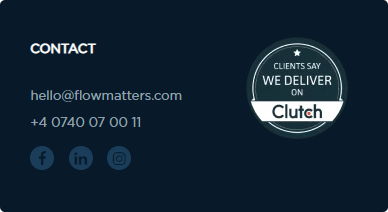
- On the other hand, our blog is designed to offer helpful information to our readers.
- The blog articles are complex and provide complete information on the discussed subject – evergreen content type.
- Even when we write more blog posts on the same subject, we approach the issue from a different perspective.
- We avoid duplicate content.
- We update our blog content constantly by publishing a new article every week.
Having a fast performing website
It is easy to build a beautiful website, but building a reliable website that helps to reduce bounce rates and increases click-through rates is not that simple. The average conversion rate across all industries is less than 2.5 %. In order to get higher conversion rates and improve search engine optimization, you will have to study your audience and give them what they need and expect from you.
Besides all SEO factors to consider, you must pay attention to the technical approach of making your website achieve faster load times and be optimized for mobile searches. When we talk about SEO, we have a couple of recommendations: avoid keyword stuffing, get rid of outdated content, focus more on the current content, fix all broken links, etc. These are the basics of SEO that every business should implement. Furthermore, you must pay attention to the technical approach of making your website move faster on mobile and desktop versions, improving mobile speed, and optimising it for mobile searches. In the next chapter, we will get into more details on how we managed to improve our site speed from a 69 to a 97-speed score on mobile and from an 84 to a 97-speed score on the desktop.
Here is how we do it:
- Google Search Console is our best friend when it comes to SEO implementations and the overall search landscape.
- Core Web Vitals helps us identify issues that might occur on all web pages and influence the three aspects of user experience (UX) – loading, interactivity, and visual stability.
- We have uploaded our website’s XML sitemap to help Google find and crawl our pages. There are plenty of tools that create XML sitemaps. We recommend the Yoast tool for sitemap creation.
- For development improvements, we use the speed test tool Google PageSpeed Insights, GTmetrix and WebPageTest.
Converting users into customers
The end goal of each business is to convert visitors into customers. No matter the industry you are in, your objective is to sell your products or services. The best way to do this is to provide as much helpful information to your users as possible. Giving your audience what it wants will help you build trust. When your products and services quality aligns with your promise, your customers will become loyal to your brand.
Firstly, you have to attract your audience. Here, a blog plays an essential role in educating and making your audience want your product. SEO and conversion rate optimization work together. When your target audience’s expectations are met, you will turn a simple site visitor into a customer.
Here is how we do it:
- We provide educational content to our audience through our blog.
- In the articles, we include a section called “Our Expertise”, where we show our readers actual results, practical implementations, or advice on the subject.
- We provide case studies related to the topic.
- By including actual proof of our work, we build trust.
- We back up our work with case studies and our Clutch profile where our audience can read reviews.
What Technical Actions Did We Implement for Speed Optimization?

Since we launched our blog, we have written multiple articles on website performance optimization. We also wrote about the importance of page speed in search engine optimization. There we explained in detail the connection between page speed and SEO. Suppose you are not paying attention to technical implementations that need a developer’s touch. Your search optimization efforts alone won’t be enough. You will attract visitors to your website with a rock-solid SEO strategy, but you cannot meet their expectations and engage them if your website is slow loading, full of bugs and visually unstable. Also, you must include mobile users and make sure they have a flawless mobile experience. Besides mobile responsiveness, page speed is also a crucial ranking factor.
Let’s get into the optimization actions that we implemented on our website:
Gathering Data
- First and foremost, we started by gathering data about the state of our website.
- We used Google PageSpeed Insights, GTmetrix and WebPageTest.
- We tested every single page on our website to see where we stand.
- Some pages performed better than others, but the overall performance of our website was average.
- Based on the report’s recommendations, we started to look for solutions to help our website perform better.
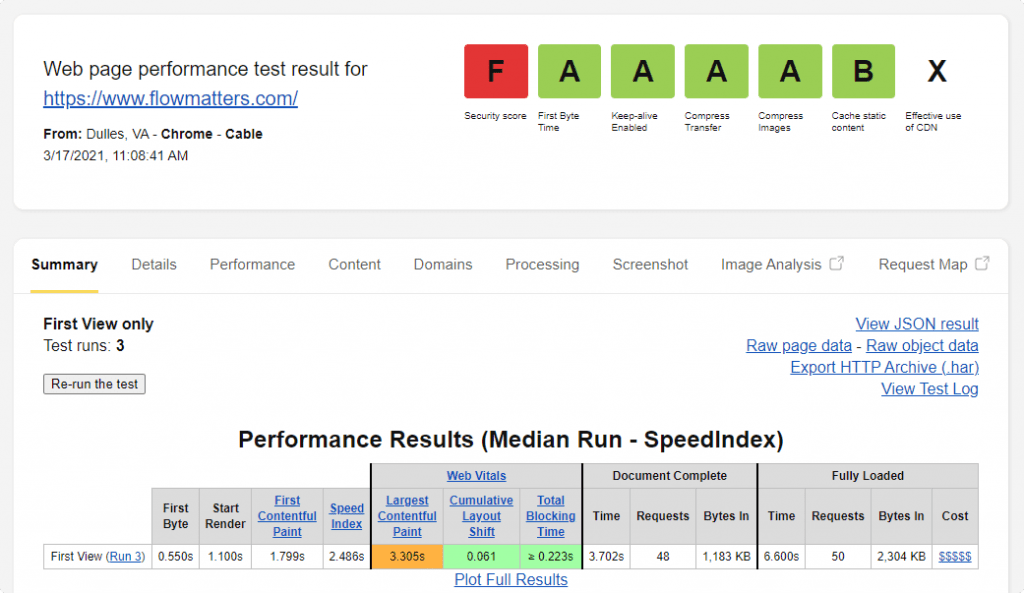
What needed to be improved?
- Webpage Security Score – some JavaScript Libraries had vulnerabilities.
- Largest Contentful Paint (LCP) – this user-centric metric measures the perceived load speed. It pinpoints the moment in the page loading timeline when the main content is likely to load.
- Cumulative Layout Shift (CLS) – another user-centric metric that measures visual stability. You can evaluate how often users encounter unexpected layout shifts.
- Time to First Byte (TTFB) – this measures the server response time, and it means the amount of time it takes from when a request is made and how fast the request is receiving the first byte of data from the server.
- Requests – a request is an action that has to be performed on a resource identified by the request-URL.
- Page Load Time – measures the average amount of time it takes for a page to fully load on a user’s screen.
- Page Speed Score – is measured in points, and it shows the performance of your website on mobile and desktop devices.
Technical implementations
- We started by removing unused JavaScript – we dequeue Contact Forms 7 scripts and reCaptcha from WordPress pages without forms. Contact Form 7 is a WordPress Plugin that displays and manages contact forms. Because a contact form is often used to flood the inbox with spam emails, this plugin integrates Google reCaptcha Service as a measure of prevention against spam.
- We implemented code snippets that verify if the pages are either the contact us page or posts from the custom post type “jobs”. If one of those two conditions are met, the scripts are not dequeued. If none of the conditions is met, the scripts are automatically removed from the page.
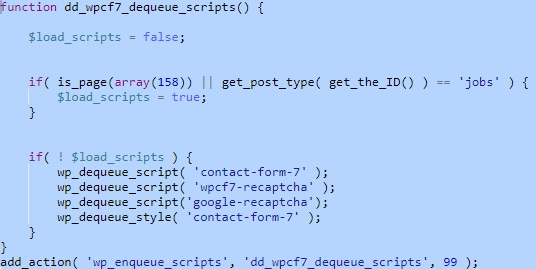
- To reduce the page size, which also impacts LCP in some cases, we added support for different size images for uploaded media and regenerated the thumbnails. We have replaced the <img scr> code with wp_get_attachment_image. When we upload a new image in the media library, this code creates a resized image of the specified dimensions. We implemented this code to extend the WordPress standard upload resize image dimensions.

- We implemented setTimeout on scripts such as Facebook Pixel and Clutch Reviews for a faster loading time. This action delays the loading of the selected scripts and allows the important content to load first.
- For LCP improvement, we use TinyPNG, an online image compression tool. The purpose is to have an image file size as small as possible without losing its quality. Running tests on the speed tools such as PageSpeed Insights will help you determine what images need to be compressed. Also, as best practice, when you upload the images, we recommend using textual content to help search engines understand the image’s meaning.
- We moved the analytics scripts to be served locally. For this, you need to create a cron job that updates Google Tag Manager and Analytics.js. Also, it would be best if you replaced links like http://www.google-analytics.com/ with your site path to the files.
Results
We got fantastic results after we made the implementations mentioned earlier. We managed to score 97 points for mobile and desktop devices, we improved the loading time from 3.7 seconds to 2.5 seconds, we reduced the number of requests from 48 to 23, and the HTML size is 34.7 KB.
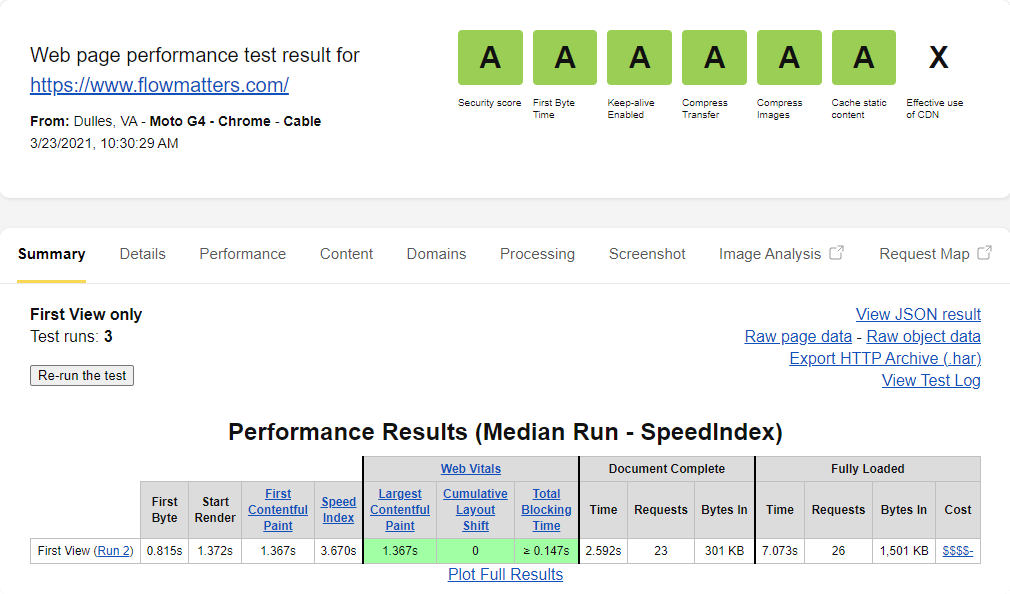
What Results Did We Achieve? A 2020 to 2021 Comparison
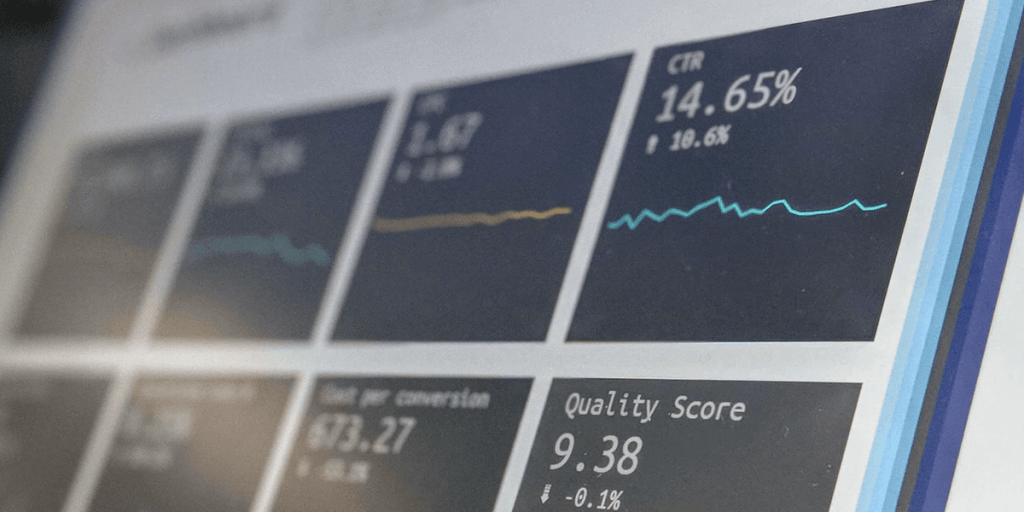
Website performance optimization and SEO efforts need continuous action. They are not one time only implementations. Many factors contribute to changes in performance, such as new content, expanding your website, user behaviour, Google Core updates, etc. Due to the continuous evolution of the online environment and the emancipation of online users, we strongly recommend you keep up with the latest updates, trends, and rules.
Google is usually launching three times a year, a broad core update that changes how their search algorithm behaves for all countries and languages. In 2020, three core updates rolled out in January, May, and December. The core update in May had the most impact on the search rankings for industries such as health, entertainment, real estate, travel, and tourism. These core updates aim to bring a better search experience for users and boost fast performing websites with quality content on the search results page. We strongly advise you to be prepared for core updates with a fast page speed, excellent website performance, and user-oriented quality content. If these conditions are met, you don’t have to worry about being hit by the rollout of Google’s core update. We advise you to respect best practices, have a good page speed, write clear and relevant content that respects the rules of an academic document (includes headings, sections, sub-sections, introduction, body and conclusion).
In the previous sections of this article, we have explained the importance of reaching your audience, attracting them to your website, keeping them engaged, and converting them into customers. Every action that we take must be user-centric.
Let us show you how we evolved in one year; after we put together a blog, we made constant search optimization and speed improvements.
- As you can see below, the primary traffic source for us is organic search, and we have a 778.57% increase in 2021 compared to 2020.
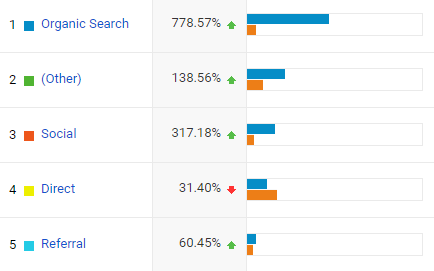
- In 6 months, our organic growth increased by almost 1200%. This growth is mostly because of our blog.

- In 2021, the number of new users on our website increased by 30%.

- The Average Session Duration increased by 71.47% in 2021.

- The Bounce Rate decreased by 8%.

- The Page Views increased by almost 50% in one year.

We wanted to show you our results to understand better the power of quality content, search engine optimization, and ongoing website improvements. Patience and consistency are the keys to success.
We are here to help you achieve the results you always dreamed of. Website performance optimization needs a keen eye and at least one skilled person to implement the necessary actions. Contact us, and let’s start improving your business!
Frequently Asked Questions
No! Each website is different and needs distinct actions. Before starting any optimization process, we gather data about the website’s current state and act according to the findings.
They are both critical. SEO will make your website more discoverable, reach new audiences, and attract them to your website. Site speed will keep your users engaged and will convert them into customers. SEO and site speed go hand in hand.
In terms of page speed, the results are immediate. In terms of SEO, it will take longer, but usually, you can see results in 3 to 6 months.